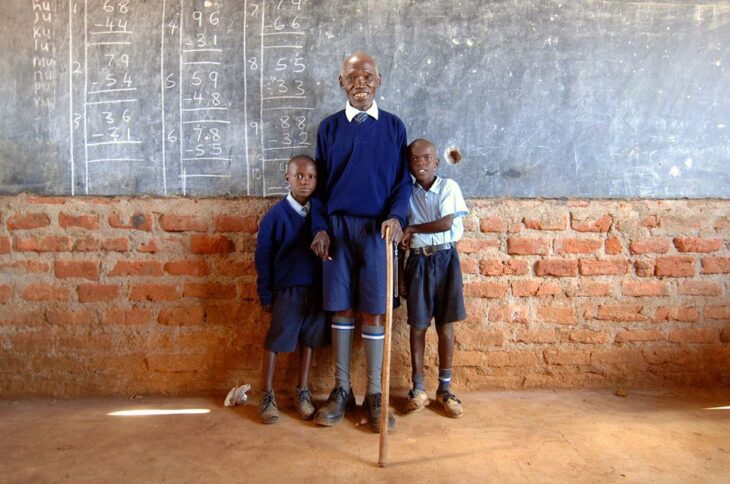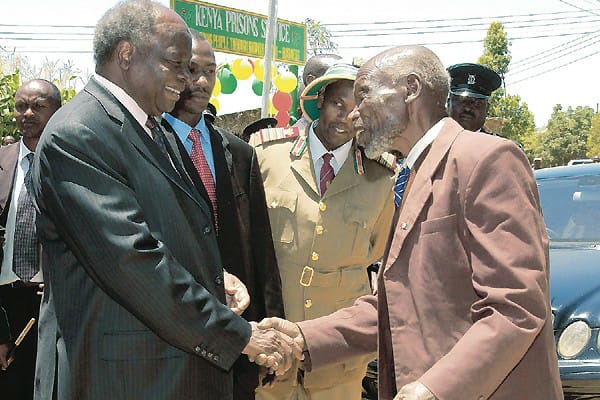NAIROBI, Kenya, Apr 26 – On January 12, 2004, octogenarian Mzee Kimani Ng’ang’a Maruge made global headlines after becoming the world’s oldest person to enroll in primary school at the age of 84.
The late Mau Mau veteran was able to fulfill a lifetime dream after opposition parties under the National Rainbow Coalition (NARC) gained power with the late Mwai Kibaki becoming the country’s third president ending late president Daniel Toroitich Arap Moi’s 24-year grip on power.
One of the campaign pledges of Kibaki’s would-be government was to introduce free and universal education.
And after the dream became a reality, millions of disenfranchised Kenyan children from all over the country for the first time, enrolled in school to receive basic education.
According to statistics from the Ministry of Education, enrollment in primary school rose from 5.9 million pupils in 2002 to 7.2 million in 2003. The numbers gradually increased to 8.2 million pupils by 2007.
As the free primary education programme gained global plaudits, Mzee Maruge became the ‘poster child of this education success story in the initial days, after he enrolled in standard one in 2004 at Kapkenduiywo Primary School in Eldoret, in the now Uasin Gishu County.
During an interview at the time, Mzee Maruge cited ‘divine intervention as one of the reasons he decided to join the school for the first time.
“I was shown by God to go to school and he encouraged me to study, that is why I am back in school,” he said.
Alongside the need to learn more about God, during another interview after being baptized in 2009, Maruge said learning to read and right had given him a better perspective of how the world operates.
“The preachers misled people, that is why I wanted to learn how to read the bible, I wanted to see where it could take me,” he said.
Throughout his period in school, teachers described Maruge as a bright and disciplined pupil despite challenges brought about by his old age.
In 2005 he would further make headlines after traveling to New York in the United States to address the United Nations 2005 World Summit on the importance of primary and secondary education for all children.
Around the same period, former US president Bill Clinton heaped praise on the Free Primary Education (FPE).
“How many people have we missed because they did not have the chance to show what was in their minds? The world is better when we work together, have enough chances, and when no one stands in the way of others,” said Clinton.

Maruge would during the post-election violence of 2007 be forced to drop out of school and relocate to Nairobi where he would resume learning at Marura primary school in Kariobangi.
Months later while in the care of the Kariobangi Cheshire Home, he dropped out of school due to illnesses before passing on August 14, 2009, as a result of Stomach cancer.
His tales of triumph and zeal for education would eventually be immortalized in a feature film titled: The First Grader in 2011.
Kibaki’s Vision For Free Primary Education
As an academic, former president Mwai Kibaki understood all too well the importance of education.
As the leader of a nation, his dream of introducing mandatory basic education to all Kenyan children was particularly critical if the country would boost its fortunes by educating a large percentage of the population who would in turn participate in nation-building and most importantly accord themselves and their family a decent life filled with dignity and respect.
During the same time as millions of learners joined the primary school, the World Bank observed that the programme had lifted the country ahead of regional nations such as South Africa.
For the FPE to fully become a success, funding became absolutely critical with existing schools said to have lacked the capacity to accommodate the ballooning learners.
As the scramble for quality education kicked off, critics of the programme cited a lack of proper planning that nearly ‘destroyed’ public schools since a lot of parents opted to have their children join private schools.
Though the Kibaki government lured in learners with the perks of free tuition and even books, only requiring parents to purchase school uniforms, enrollment soared…though much was still required from the government to improve learning with demand for increased classes and teachers amidst congestion of leaners.
Critics even cited the challenges as the reason the academic performance in public school deteriorated over time.
“Despite the heavy challenges of free education, we are committed to ensuring a conducive learning environment for students,” Kibaki said.
In 2008, Kibaki would after a contested election that plunged the country into violence alongside former prime minister Raila Odinga institute plans for free secondary Education.
“From January 2008, my government will meet the cost of tuition in all public secondary schools at a cost of Sh4.3 billion,” said Kibaki.
This saw learners enjoy secondary school for free (Day School) with parents only being required to pay for boarding costs.
Kenya still remains on course to achieve global goals like the Millennium Development Goals which champion for education for all children.
Uhuru’s Government Sought To Build on Kibaki’s Foundation
Since 2013, the Jubilee government is said to have continued to actualise the right to education and increase access to quality education for every learner in all public schools by allocating Sh1,420 per year to each public primary school learner.
This amounts to Sh94.95 billion to learners in 22,998 public primary schools and a total of Sh3.44 billion to 216,420 SNE learners in 2,059 public primary schools.
“We have been consistent to track each cohort as it transitions to each class over the last 10 years right from the time they entered Class One to the time they sat their KCPE. Thanks to the programme, the country has stood tall in the region, posting impressive net and gross enrollment and retention rates,” said Education CS Prof George Magoha.
“The Government of President Uhuru Kenyatta has sustained the push to have every KCPE candidate gets enrolled in Form One and progresses to Form Four. I am proud to have led the campaigns that have achieved the 100 per cent transition of two KCPE cohorts (2019 and 2020). This has seen enrolment in secondary schools’ grow from 1.3 million in 2008 to 3.5 million in 2022.”
Under the Jubilee administration, capitation for Free Day Secondary Education (FDSE) rose from Sh12,870 to the current Sh22,244.
Since 2013, the capitation to public secondary school learners’ amounts to a total of Sh325.67 billion to Sh23,832,734 learners in public secondary schools and a total of Sh1.52 billion to 34,194 SNE learners in 768 public secondary schools according to statistics from the ministry of education.
Want to send us a story? Contact Shahidi News Tel: +254115512797 (Mobile & WhatsApp)


